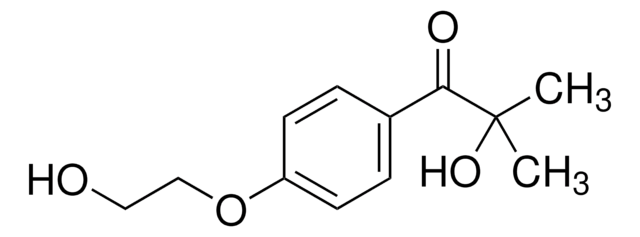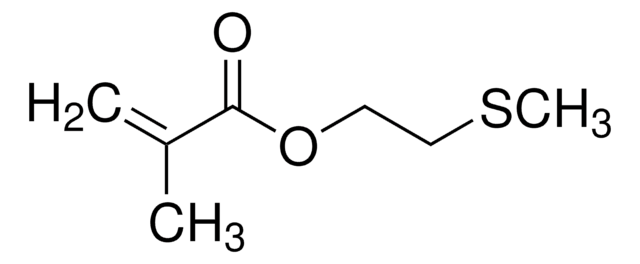735094
Bis(2-methacryloyl)oxyethyl disulfide
contains ≤6000 ppm hydroquinone as stabilizer
Synonym(e):
DSDMA, Disulfide-based dimethacrylate
About This Item
Empfohlene Produkte
Form
liquid
Enthält
≤6000 ppm hydroquinone as stabilizer
Brechungsindex
n20/D 1.517
Dichte
1.141 g/mL at 25 °C
Lagertemp.
2-8°C
SMILES String
CC(=C)C(=O)OCCSSCCOC(=O)C(C)=C
InChI
1S/C12H18O4S2/c1-9(2)11(13)15-5-7-17-18-8-6-16-12(14)10(3)4/h1,3,5-8H2,2,4H3
InChIKey
CGDNFXSLPGLMHK-UHFFFAOYSA-N
Verwandte Kategorien
Allgemeine Beschreibung
Anwendung
- Used as a crosslinker in the synthesis of reduction-responsive molecularly imprinted polymer (MIPs) nanogels for drug delivery applications. This reduction-responsive property allows for control over drug delivery and modulation of the release properties of the MIPs.
- Used as a crosslinker in the synthesis of self-healing polymer nanocomposites via dynamic disulfide exchange reaction and crosslinking properties. These self-healing polymer nanocomposites can be used in coatings, electronics, and packaging applications.
- Used as a redox-responsive cross-linker in the synthesis of zwitterionic hydrogels for effective drug delivery. DSDMA provides structural stability, redox-responsiveness, and self-healing properties, which are essential for effective drug delivery.
H-Sätze
P-Sätze
Gefahreneinstufungen
Aquatic Chronic 2
Lagerklassenschlüssel
10 - Combustible liquids
WGK
WGK 3
Flammpunkt (°F)
Not applicable
Flammpunkt (°C)
Not applicable
Analysenzertifikate (COA)
Suchen Sie nach Analysenzertifikate (COA), indem Sie die Lot-/Chargennummer des Produkts eingeben. Lot- und Chargennummern sind auf dem Produktetikett hinter den Wörtern ‘Lot’ oder ‘Batch’ (Lot oder Charge) zu finden.
Besitzen Sie dieses Produkt bereits?
In der Dokumentenbibliothek finden Sie die Dokumentation zu den Produkten, die Sie kürzlich erworben haben.
Unser Team von Wissenschaftlern verfügt über Erfahrung in allen Forschungsbereichen einschließlich Life Science, Materialwissenschaften, chemischer Synthese, Chromatographie, Analytik und vielen mehr..
Setzen Sie sich mit dem technischen Dienst in Verbindung.






